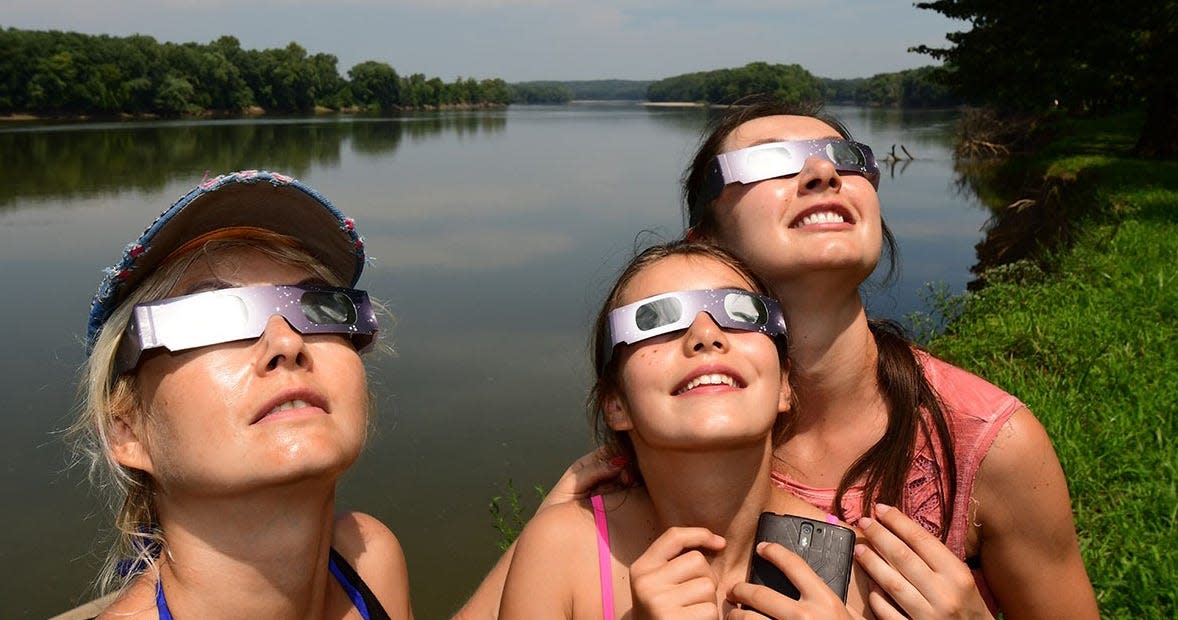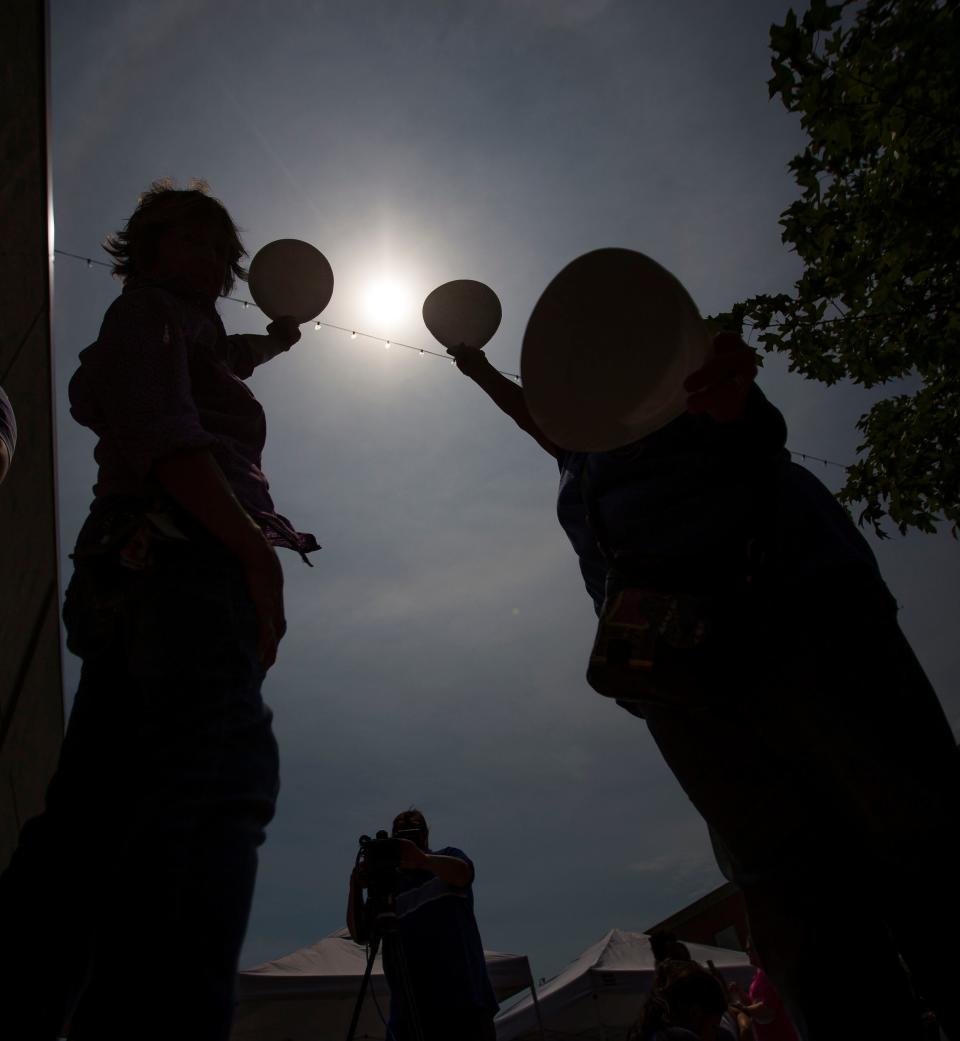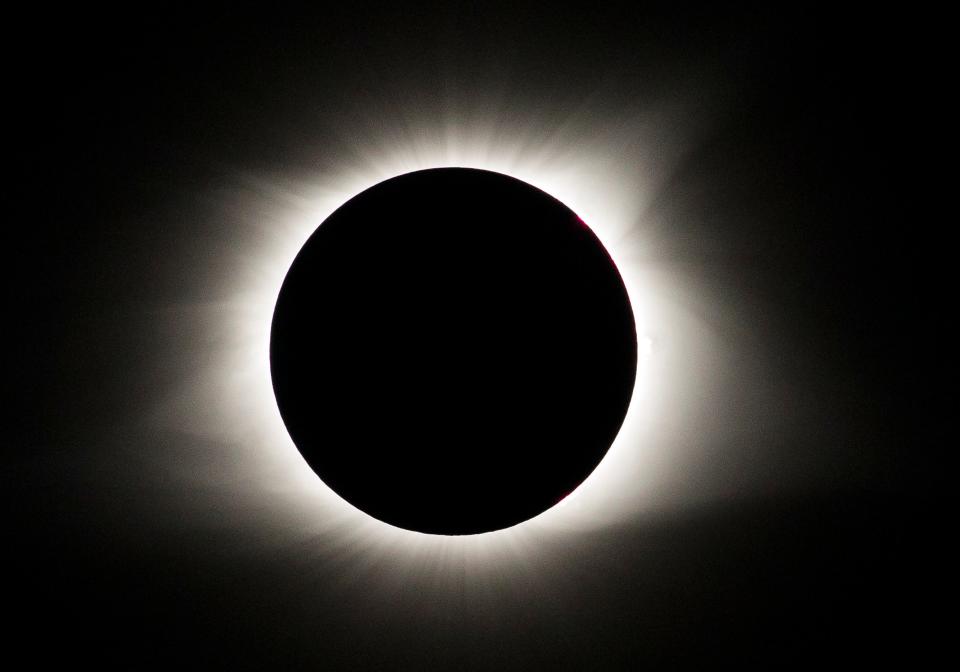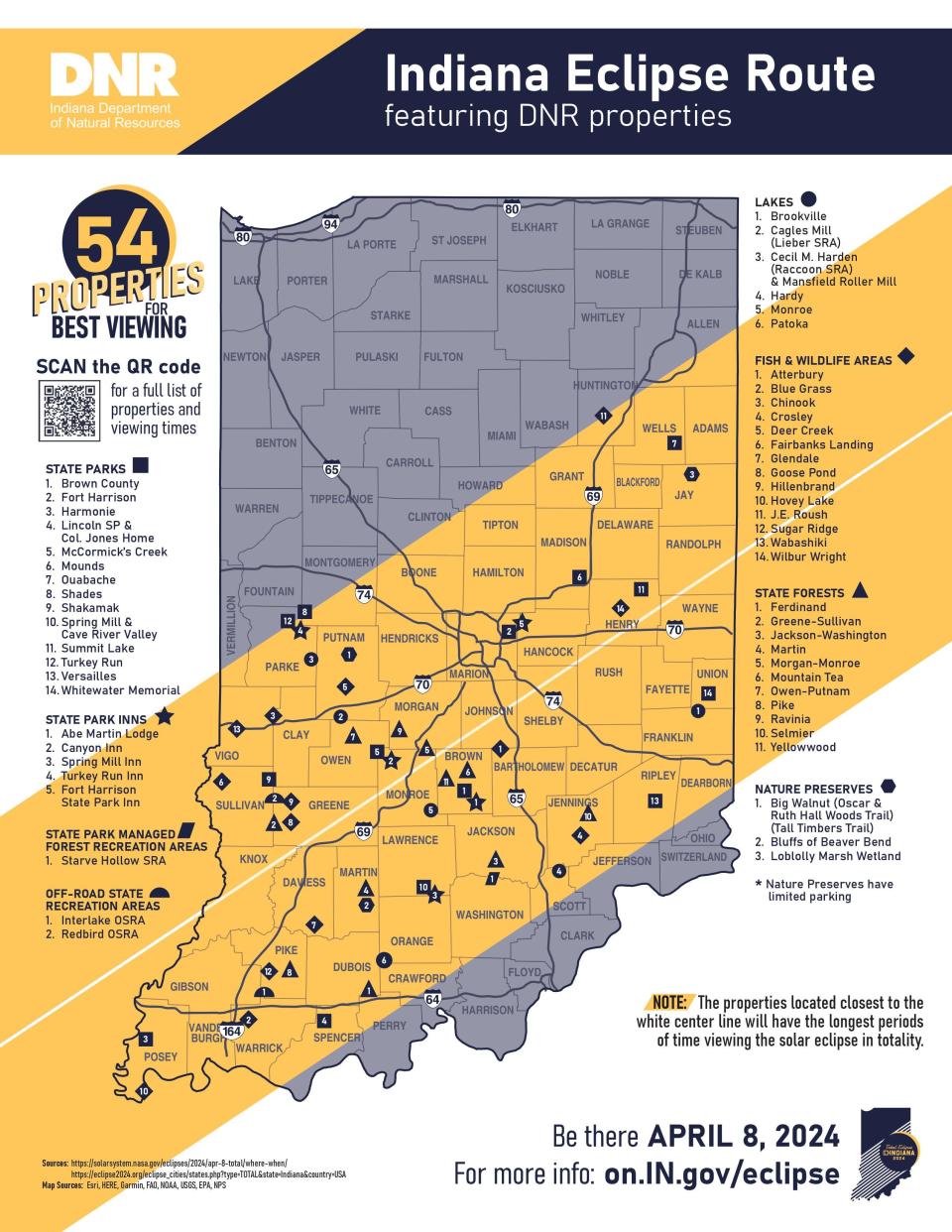Should you travel for eclipse totality or see bizarre solar tricks here? What to consider.

Here in Michiana, the moon will eclipse the sun by an impressive 97% for the solar eclipse on April 8, but the difference between that and totality — roughly 100 miles south of South Bend — is still “night and day,” sky watcher Chuck Bueter of Granger says.
That's not to pooh-pooh the bizarre tricks of science we’ll still see here, if you’re ready and if you pay attention.
Do you endure the frustrations and travel south among the thousands for the experience of a lifetime? The path of totality will cover much of central and southern Indiana. But state parks alert you to expect long lines and congested roads. Only limited campsites are still available at a few state parks in the path of totality — Brookville Lake, Patoka Lake, Prophetstown, Shades and Versailles — while ample sites are available outside of totality. Motel rooms, if they are even available, will come at a lofty price.
Or do you stay put for the show here, where several parks, universities, libraries and others will host free viewing events? (Watch for a full local listing in The Tribune.)

Watching locally: Get ready for the celestial show the eclipse will put on April 8, here and downstate
For many years, Bueter has studied, blogged and educated others about the sky’s phenomena as a member and past president of the Michiana Astronomical Society.
He says it’s going to be a “vastly better” experience here than in 2017, when the local area saw only an 88% eclipse.
He was in Idaho in 2017 and was blown away by witnessing totality. This time he’s heading to the greater Indianapolis area. And just last week, he observed a crescent moon at 3% and was amazed at how tiny of a sliver it was. As he compares that to a 3% sliver of sun we’ll see in Michiana, he remarks, “It (the sun) is going to be really, really small.”
Even that tiny fragment of light will still be so sharp that you can only safely look at it through protective eclipse glasses. These special glasses, saving you from permanent eye damage, will be given out for free at local events.

In totality, by contrast, people will be able to look at the full eclipse with their naked eyes and see the sun’s corona — the dazzling, uneven outer parts of the sun.
How dark will it get?
So, what will the eclipse darkness look like here in Michiana when we experience maximum blockage at 3:08 p.m.? Keep in mind that the moon will start passing in front of the sun at 1:53 p.m. and be beyond it by 4:23 p.m.
Bueter admits that’s tricky to answer. He recalls totality in 2017 when, he says, "Even then, we could see a modest 360 degree sunset glow all around us."
It’s hard to compare the light of Michiana’s eclipse to twilight or dawn because, at those times, the sunlight is more diffused, working its way through more levels of atmosphere, which causes the warm reddish colors, Henry Scott, physics and astronomy professor at Indiana University South Bend, says. During the eclipse, it will be the much brighter, direct rays of the midday sun that are pinched down to a fragment.
At 3% sun, Scott says, “It’ll be closer to day than night.”
From IndyStar: The total solar eclipse is just weeks away. Here's everything you need to know
In totality, you’ll see stars. Here in Michiana, Bueter says, we won’t see stars, but we’ll see the brightest planets, like Venus.
Still, you might find degrees of difference even within Michiana. Bueter points out that the Indiana-Michigan line will be at 96.8%, Osceola will be at 97.1%, Bremen will be at 97.7% and Wabash — about 80 miles south of South Bend — will be a 99.8%.
Kokomo will be on the edge of totality, and it could even make a difference from the north side to the south side of town, Bueter says.
Weird science in Michiana
If all you’re looking for is a darkened sky, he says, you’re missing out on cool, easy-to-notice marvels of nature. Here are some you’ll be able to see in Michiana in the minutes leading up to and through the eclipse.
∎ Look at any shadow. It might be interesting to look at the shadow of your hand or head. Some edges of the shadow will be sharper than usual. Normally, the edges of shadows are fuzzier because the sun is sending light at us from a broader range of angles. In an eclipse, the light is reduced to more of a direct beam. On a round object, the sharp edges will be at polar opposites, while fuzzy edges will remain at the other two edges.
∎ Look for crescent images of the sun. You will see this if you poke a hole through a piece of paper or cardboard and let sunlight stream through it. You can also create such a gap with your fingers. Then let the sun project an eclipsed image of itself through the hole — keep checking on these every so often to see how the sun’s “selfie” image changes, all the way up to a crescent. Bueter suggests taking aluminum foil and poking holes to spell out a word or your name or even a picture.
∎ Purkinje Effect. Wear red or green to the eclipse and encourage others to do the same. That’s because the eclipse will cause warm colors (red) to fade and cool colors (green) to become more vibrant.
∎ Critters get confused. As darkness sets in, crickets will sing like it’s nighttime. See if you can be close to a grassy field. Birds will start heading to their roosts and some may switch to their evening calls. Animals, in general, may do what they normally do when night is coming, followed by morning.
From IndyStar: How will the eclipse affect Indiana's wildlife?
Ready to roll?
When the eclipse does come, Bueter advises, be situated, be relaxed and have a plan so you can watch and appreciate the different phenomena. You don’t want to scramble because your kid suddenly says she’s cold, because the momentary darkness does cool things off. Have a jacket handy.
“When it comes,” he says, “everything is going to happen fast.”
“You’re within 100 miles of an eclipse in your lifetime,” Bueter adds. “This is as good as it gets.”
Scott isn’t one who normally gets up at wee hours or travels to see phenomena of the skies — often because he’s got kids — but this time, he’s motivated because he’s never experienced totality and expects a “breath-taking experience.” He’ll head to his family’s home on Lake Erie.
“If you can’t travel,” he says encouragingly, “it’s still going to be pretty great to see 97%.”
Tips for travelers
Travel to the south will likely be busy in the weekend leading up to the eclipse on Monday, April 8. But what happens once the eclipse is over? Will everyone suddenly decide to scramble home on April 8 so they can return to work on Tuesday? You may want to figure on staying put a while to let traffic cool down first.
Indiana’s Department of Natural Resources offers this advice if you’re determined to watch the eclipse from a park within the range of totality:

∎ Arrive early and stay put. Entrance gates to Indiana State Parks (where they exist) open at 7 a.m. When parking areas fill up, gates will close to cars and pedestrians.
∎ Bring your annual pass. It will help the lines move more quickly.
∎ Bring cash, expect slow wireless connections. You’ll be among thousands vying for the same cellphone connections. Cash will help if you’re trying to pay when services are down.
∎ Bring lawn chairs, provisions and patience. Some but not all parks may be selling food. Come prepared for a packed park. Bring extra snacks, water and first-aid supplies/medicines in case you’re stranded.
∎ Fill your gas tank before you come. There could be gridlock as you leave.
∎ Monitor traffic. Visit INDOT TrafficWise or 511IN.org.
∎ Find more travel safety info: www.in.gov/dhs/solar-eclipse-2024.
Eclipse resources
∎ Nightwise: Learn more about the eclipse and fun projects you can do at Bueter’s blog: www.nightwise.org/blog/tags/solar-eclipse. Also, watch a 46-minute video with an “eclipse blitz” of information and tips, linked here in this column online.
∎ Eclipse simulator: See what the eclipse will look like anywhere in the world at Eclipse2024.org.
∎ Eclipse notifications: Download an app for $1.99 to give you moment-by-moment notifications of what to watch during the eclipse. There’s also a 548-page book, if you want, for $49.99 in print, $9.99 in digital version. Visit www.solareclipsetimer.com.
Bicycles (not eclipsed)
∎ Melting Mann race: Grind away March 23 on dirt and paved roads, including the notoriously hilly Mann Road, for 24, 35 or 60 miles out of Swiss Valley Ski & Snowboard Area in Jones. Cost is $80. Details are at meltingmann.com.
∎ Bike swap meet: Are you looking for a used bike so you can start cycling again? Need to trade off some old parts or accessories? You'll definitely want to visit the annual bike swap meet, which returns from 11:30 a.m. to 2 p.m. March 24 in the big red barn at St. Patrick’s County Park, 50651 Laurel Road, South Bend. Admission to the park and event is free. It's sponsored by the Michiana Bicycle Association and the Northern Indiana Mountain Bike Association, which will both be there with information about their rides.
Find columnist Joseph Dits on Facebook at SBTOutdoorAdventures or 574-235-6158 or jdits@sbtinfo.com.
This article originally appeared on South Bend Tribune: Should you travel Indiana for solar eclipse totality or stay South Bend

